| Laws Of Bridge |
DUMMYS RIGHTS:
Dummy is entitled to give information, in the Director’s presence as to fact and law.
He may keep count of tricks won and lost.
He plays the cards of the dummy as directed by declarer.
Dummy may ask declarer (but not a defender) when he has failed to follow suit to a trick whether he has a card of the suit led.
He may try to prevent any irregularity by DECLARER.
He may draw attention to any irregularity, but only after the play of the hand is concluded.
DUMMY'S LIMITATIONS:
Unless attention has been drawn to an irregularity by another player, dummy should not initiate a call for the Director during play.
Dummy may not call attention to any irregularity during play.
Dummy must not participate in the play, nor may he communicate anything about the play to declarer.
Dummy may not exchange hands with declarer.
Dummy may not leave his seat to watch declarer’s play of the hand.
Dummy may not, of his own initiative, look at the face of a card in either defender’s hand.
Dummy is liable to penalty for any violation of the limitations listed.
If dummy is the first to draw attention to a defenders irregularity, there is no rectification. Play continues as though no irregularity had occurred.
Once declarer has called for a card from the wrong hand, either defender may choose the hand from which declarer shall lead.
|
|
|
|
Players have an obligation to abide by the Laws of Bridge, so whilst you do not need to be able to give a ruling and even if you can you should NOT and MUST CALL THE DIRECTOR ( Law 81C : The director (not the players) has the responsibility for rectifying irregularities and redressing damage. )
Perhaps the most important Law of bridge in a club is Law 74 : Conduct and Etiquette.
74A Proper Attitude ...1. A player should maintain a courteous attitude at all times,.
|
|
|
|
| The Laws of Bridge |
Our new series of articles will be snippets relating to the Laws of Bridge. Players have an obligation to abide by these Laws, so whilst you do not need to be able to give a ruling and even if you can you shouldn't and must call the director of the day, you need to have a working understanding of the Laws.
First we will clarify som terms
A BID : An undertaking to win at least a specific number of tricks. eg 1♠ , 1NT
A CALL : Any bid, double, redouble or pass.
SO ALL bids are CALLS, but not all CALLS are BIDS.
|
|
|
|
The Suicide King
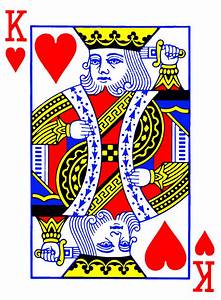
The king of hearts is sometimes called the Suicide King because the sword he holds behind his head might be visualized as being used to stab himself in the head. This design evolved from earlier designs where he was holding a battle axe, but over the course of copies being made, the axe head was omitted, and the weapon changed to a curiously positioned sword.
The King of Hearts might represent: Charlemagne, a European king, who lived from 747 to 814 AD.
Charlemagne attained a status of almost mythical proportions in the West. Among other things, he was responsible for uniting most of Europe under his rule by power of the sword, for helping to restore the Western Roman Empire and becoming its first emperor, and for facilitating a cultural and intellectual renaissance, the ramifications of which were felt in Europe for centuries afterward.
The King of heart is also of course the husband of the queen of hearts in Alice's adventures in wonderland.
|
|
|
|
King of Spades
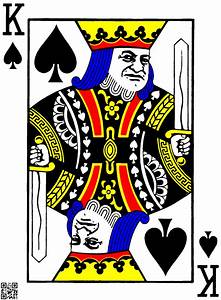
As we have already discussed, the origins of European playing cards are highly speculative, with Chinese, Indian, and Persian parentage all claimed of them. Despite our lack of knowledge concerning exactly how playing cards came to Europe, we can determine when they arrived with a fair degree of certainty, we are reasonably safe in stating that playing cards first arrived in Europe in the latter part of the fourteenth century.
The French suit symbols were more easily stenciled than their earlier counterparts, than other nationalities and the French card masters soon realized they did not need to engrave each of the twelve court cards separately, as their German competitors did. The French simply created one wood block or copper plate for each of the three royals, printed the cards from them, and stenciled the suits in later. The French were thus able to outproduce German card makers, and so the French design eventually became the standard for most of Europe. It was at about this time that the French card masters also started the practice of assigning identities to the royals pictured on their court cards . All of the court cards (not just the kings) were named, and the identities assigned to them (and printed on the cards) were by no means consistent. The choice of names differed from master to master, often with no apparent reason behind them other than personal preference or whim. On French cards, the spades are said to represent the aristocracy (as spearheads, the weapons of knights), this is mere historic speculation again, however.
Quizzers will "know! the King of Spades represents King David. King of Israel from the old testament of the bible.
|
|
|
|
Jack of Hearts
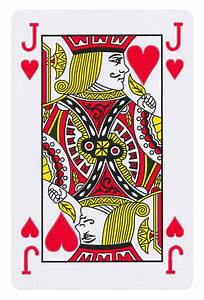
The Jack of Hearts is the last card we will be featuring in this series. As a card he isn't very exciting but the name has been used for more adventurous stories.
He is a fictional superhero in the Marvel comics called Jack Hart, also a member of the Royal Flush Gang in DC Comics.
There was a British crime drama series in 1999 Jack of Hearts (TV series) and the title of various plays and films; an Australian comedy play by David Williamson a 1986 Canadian short film based on a story by Isabel Huggan, a 1999 U.S. film directed by Serge Rodnunsky and starring Nick Mancuso and a 1919 American short Western film directed by B. Reeves Eason
Lily, Rosemary and the Jack of Hearts, is a song by Bob Dylan, from the 1975 album Blood on the Tracks
|
|
|
|
Queen of Diamonds
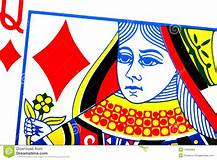 As with all the court cards there is suggestion that the queen of diamonds depicts a famous figures, in this case, Rachel from the bible. As with all the court cards there is suggestion that the queen of diamonds depicts a famous figures, in this case, Rachel from the bible.
Rachael, was the favorite wife of Jacob. He had two wives and the other was Rachael's sister, Leah. How Jacob came to be married to two sisters is an interesting tale.
She was the second daughter of Laban. Jacob saw her watering her fathers stock whilst staying with her father Laban. During his stay with her family he fell in love with her. In order to gain her hand in marriage he agreed to work for seven years for her father.
On the night of the wedding, the bride was veiled and Jacob did not notice that Leah, Rachel's older sister, had been substituted for Rachel. Later Jacob confronted Laban, who excused his own deception by insisting that the older sister should marry first. He assured Jacob that after his wedding week was finished, he could take Rachel as a wife as well, and work another seven years as payment for her!
|
|
|
|
NAYMATS convention that employs a 4-of-a-minor opening to show a strong 4-of-a-major opening.
4 = A strong 4 = A strong 4 opening opening
4 = A strong 4 = A strong 4 opening opening
What does "strong" mean? Let's assume you deal with nobody vulnerable. Consider these two hands:
A)  5 5 K Q J 10 7 6 5 3 K Q J 10 7 6 5 3 4 3 4 3 5 4 5 4
B)  -- -- A Q J 10 8 7 6 2 A Q J 10 8 7 6 2 K Q 2 K Q 2 4 3 4 3
With both hands, you'd like to preempt 4 to make it difficult on the opponents. The first hand is somewhat normal, but the 2nd hand is really too good to preempt--you could easily miss a slam. Playing Standard, I'd open Hand A) with 4 to make it difficult on the opponents. The first hand is somewhat normal, but the 2nd hand is really too good to preempt--you could easily miss a slam. Playing Standard, I'd open Hand A) with 4 , but Hand B) with 1 , but Hand B) with 1 . .
Playing NAYMATS, you still open Hand A) with 4 , but can open Hand B) with 4 , but can open Hand B) with 4 to tell partner you have "extra." to tell partner you have "extra."
The exact amount of extra depends on vulnerability and position. If vulnerable, a 4-level preempt is sound to begin with, so a Naymats opening would be even better than sound. Still, the hand can't be too strong; I would open 2 , not Naymats (4 , not Naymats (4 ) with: ) with:  A K Q J 8 7 6 2 A K Q J 8 7 6 2 A Q A Q  A 3 A 3 2. 2.
Responses
After a Naymats opening, the partner has several choices. With no slam interest, he will sign-off in 4-of-the-shown major. With mild slam interest, he can bid the in-between-step. For example, after a 4 opening, say responder holds: opening, say responder holds:  A 8 7 6 5 A 8 7 6 5 2 2  A J 5 4 A J 5 4 K 8 3. He can bid 4 K 8 3. He can bid 4 to say : Pard, I am mildly interested--if you have a little extra, please cooperate with me. This bid says nothing about diamonds--it is completely artificle.The partner of a Naymats opener can also use Blackwood, control-bid, or just bid a slam. to say : Pard, I am mildly interested--if you have a little extra, please cooperate with me. This bid says nothing about diamonds--it is completely artificle.The partner of a Naymats opener can also use Blackwood, control-bid, or just bid a slam.
When is it on?
The partnership must discuss if this is on in all 4 seats. Also, you lose the ability to open a 4-level preempt in a minor. Some pairs using Naymats play that a 3NT opener shows a 4-of-a-minor preempt.
(from a Larry Cohen article)
In case you haven't noticed, if you spell Naymats backwards, you will see a very familiar convention.
|
|
|
|
Ace of Diamonds

There is little history associated with this card and few name sakes. There is a Mexican film of the same name and the Ace of Diamond is a very famous Japanese series about baseball.
The diamond suit is the only French suit not to have been adapted from the German deck. Diamonds take the place of Bells. The original French name was Carreau and in German Karo. Often in Spanish we hear it expressed as Caro, I assumed meaning expensive. In Latin the work quadrum means square or rectangle. Since the German term derives from Latin it is possible the Spanish term is less about value and more related to the diamond shape.
For us, cards in the diamonds suit are red in colour. They can however occasionally be depicted in blue. In the official Skat tournament deck, diamonds are yellow or orange, assuming the color of their German-deck equivalent, which are usually gold.
|
|
|
|
Jack of Diamonds

The title Jack of Diamonds is used for various artistic items, a Russian school for artists, a 1949 film directed by Vernon Sewell and further films with the same title in 1967 and 2001
As with most of the cards it is also the title of a song, a traditional folk song and a 2012 novel by Bryce Courtenay
In cartomancy the Jack of diamonds represents the postman or messenger. It also symbolizes a young soldier or an unfaithful servant (assistant, employee); sometimes a young blond man, traitor and of bad morals.. If the consultant is a young man, it is the announcement of new lovers.
|
|
|
|
Jack of Spades
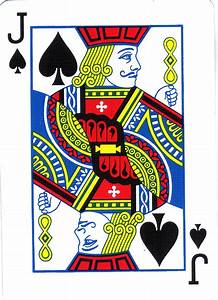
The Jack of Spades is said to represent Ogier, the Dane or in French Ogier de Danemarche in Danish Holger Danske. An important character in the French medieval epic poems called chanson de geste. There his story is told deailing with wars of the feudal barons agaist the emperor of Chalemagne. A legendary knight of Charlemagne. In particular he features as the protagonist in La Chevalerie Ogier. Later in the century, Les Enfances Ogier places him at Charlemagne’s court, highly esteemed for his military prowess, and ends with him leading the Franks to victory over the Saracens. The character of Ogier has a historical prototype in Autcharius, a follower of Carloman, Charlemagne’s younger brother, whose kingdom Charlemagne invaded in 771 after Carloman’s death. Although Ogier is referred to in the chansons as the son of the Danish king Gaufrey and later became a national hero celebrated in Danish folk song, the surname “of Danemarche” probably originally signified the marches of the Ardennes and not Denmark.
Stories about Ogier appeared in Icelandic, Castilian, Catalonian, and Italian.
The knave of Spades: growing pains of a gardener by Alan Titchmarsh where he recounts his gardening career. He tells how he moved from Yorkshire to apprentice at Kew Gardens and later follow his other love of acting and the arts to become probably Britain's best known gardener.
|
|
|
|
Queen of Clubs
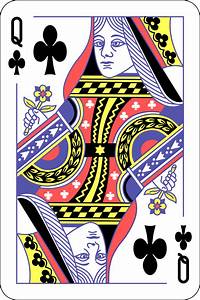
We have comment before about whether or not the court cards represent famous historical figures or not. If you follow the French assignment of characters then the queen of clubs represents Argine, from an anagram of Regina, latin for queen. She is so boring she doesn't even have her own Wikipedia page. Argine when translated into English means river bank or embankment.. In cartomancy she doesn't fair much better as she is not necessarily a good omen. She represents a dark-haired woman whose objectives are quite contrasting. Indeed, she can be malevolent and can announce a form of jealousy from ones relatives. This woman covets your professional, familial or romantic situation and may become harmful. Her meaning is complex depending with which other cards she is associated.
|
|
|
|
Ace of Clubs
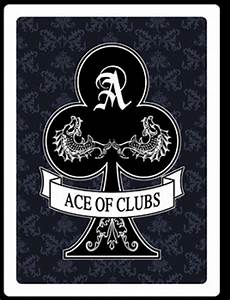
The ace of clubs has little history associated with it. Its name has been used for
- Ace of Clubs (comics), a DC Comics supervillain
- Ace o' Clubs, a DC Comics Comics bar owned by Bibbo Bibowski
- Ace of Clubs (musical), a 1949 musical by Noël Coward
- Ace of Clubs Records, a British record label owned by Decca Records
- The Ace of Clubs, an alias used by British recording artist Luke Vibert
- Ace of Clubs (film), a 1925 silent Western film by J. P. McGowan
- L'As de trèfle (The Ace of Clubs) for Sarah Bernhardt Pierre Decourcelle 1882
The word "ace" comes from Latin via old French meaning 'a unit', from the name of a small Roman coin. It originally meant the side of a die with only one pip, before it was a term for a playing card. Since this was the lowest roll of the die, it traditionally meant 'bad luck' in Middle English but as the ace is often the highest playing card, its meaning has since changed to mean 'high-quality, excellence'.
|
|
|
|
Jack of Clubs

The modern-day “jack” card came about when the Germans completely removed queens from their card decks and instead had kings, upper men (obermann), and lower men (untermann). The lower men cards became jacks. The Jacks are also sometimes referred to as knaves. They are historic figures in aristocratic or courtier dress, generally associated with Europe of the 16th or 17th century.
The Jack of clubs gives it name to an album by Paul Motian, a creek in British Columbia, Canada and a 1924 American silent crime film directed by Robert F. Hill
In cockney rhyming slang to call someone a Jack of clubs is to call them a moron. As Jack of clubs is a card and card rhymes with tard, why specifically the Jack of clubs who knows and it isn't one of the better known phrases.
|
|
|
|
King Of Diamonds
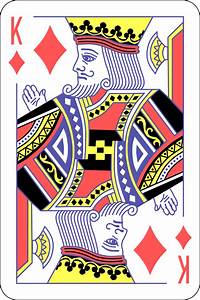
Adam Wintle, on the UK website The World of Playing Cards, says that English king cards have never been named for any historical person and supports Snopes' contention that the connection of real royals to the cards was a wholly French invention. However, other sources claim the cards reflect real life royals.
Down through the centuries, the figures in the court cards of Pierre Marechal of Rouen—kings, queens, and jacks (originally called knights or knaves)—have been dressed in the medieval clothing that was original to the 15th-century designs of the French. The King of Diamonds is widely recorded as representing the Roman Caesar Augustus. Some other sources say the king of diamonds is Julius Caesar, not Augustus. So take you pick.
As with the other cards the King of Diamonds has been the title of a film and also a TV series. He was also a fictional character in the DC comics, a member of the Royal Flush Gang.
|
|
|
|
Queen of Spades
 The queen of spades name is used for many artistic topics, such as an 1890 opera by Tchaikovsky and a song by Styx from Pieces of Eight. she seems especially popular in Russian, where there are many legends surrounding her, most of them dark and scary. In several card games, including the middle eastern Trex and French Barbu, the queen is a major card to avoid taking, each queen taken inflicts a penalty on the player and hence they have a variety of unsavoury names here as well. The queen of spades name is used for many artistic topics, such as an 1890 opera by Tchaikovsky and a song by Styx from Pieces of Eight. she seems especially popular in Russian, where there are many legends surrounding her, most of them dark and scary. In several card games, including the middle eastern Trex and French Barbu, the queen is a major card to avoid taking, each queen taken inflicts a penalty on the player and hence they have a variety of unsavoury names here as well.
In 1833 Alexander Pushkin wrote a short story, which is the inspiration for most subsequent legends. Hermann, a German in the Imperial Russian army watches other officers gamble but doesn't play himself. One night, Tomsky tells a story about his grandmother, an elderly countess. Many years ago, in France, she lost a fortune at faro (a card game), and then won it back with the secret of the three winning cards, which she learnt from the notorious Count of St Germain. Hermann becomes obsessed with obtaining this secret. In the legend, the countess (who is now 87 years old) has a young ward, Lizavyeta. Hermann sends love letters to Lizavyeta, and persuades her to let him into the house. There Hermann accosts the countess, demanding the secret. She first tells him that the story was a joke, but Hermann refuses to believe her. He repeats his demands, but she does not speak. He draws a pistol and threatens her, and the old lady dies of fright. Hermann then flees to the apartment of Lizavyeta in the same building. There he confesses to frightening the countess to death with his pistol. He defends himself by saying that the pistol was not loaded. He escapes from the house with the aid of Lizavyeta, who is disgusted to learn that his professions of love were a mask for greed. Hermann attends the funeral of the countess, and is terrified to see the countess open her eyes in the coffin and look at him. Later that night, the ghost of the countess appears. The ghost names the secret three cards (three, seven, ace), telling him he must play just once each night and then orders him to marry Lizavyeta. Hermann takes his entire savings to Chekalinsky's salon, where wealthy men gamble at faro for high stakes. On the first night, he bets it all on the three and wins. On the second night, he wins on the seven. On the third night, he bets on the ace—but when the cards are shown, he finds he has bet on the Queen of Spades, rather than the ace, and loses everything. When the Queen appears to wink at him, he is astonished by her remarkable resemblance to the old countess, and flees in terror. Lizavyeta marries the son of the Countess' former steward, Hermann, however, goes mad and is committed to an asylum. He is installed in Room 17 at the Obukhov hospital; he answers no questions, but merely mutters with unusual rapidity: "Three, seven, ace! Three, seven, queen!". Natalya Golitsyna (1741-1838), a Russian princess is nicknamed the "Queen of Spades" as she was said to be the inspiration for the countess in the novel.
Later, a film, set in the 1820s, embellishes this story and follows a man named Hermann, who has just returned from army service to Moscow. At the beginning of the film, he is in love with the beautiful young Liza - who is engaged to another - but soon he becomes fatally obsessed with learning the secret to a winning card combination from Liza's grandmother, the Countess. According to this legend, an ominous entity known as The queen of spades can be summoned by drawing a door and staircase on a mirror in the darkness, and by saying her name three times. This has become a scary ritual in Russia.
|
|
|
|
King Of Clubs
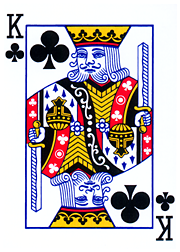
The four kings on a modern deck of playing each have a distinct appearance. But do these royals represent specific historical or mythical figures? While they did briefly have identities assigned to them by some card producers, in general, they no longer have names to put with the faces. The King of Clubs represented Alexander the Great, King of Macedonia, who conquered a vast region and lived from 356 to 323 BC. He was undefeated in battle and a great military leader, by the age of 30 he had created one of the largest empires of the ancient world, stretching from Greece to northwestern India.
King of clubs was also the name of a famous Whig (a political party) conversation club founded in 1798 and a short story by Agatha Christie in the Poirot's Early Cases.
|
|
|
|
Ace of Hearts
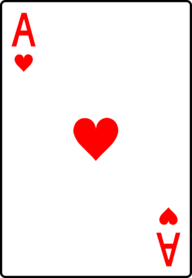
Despite it's high ranking and nice name, this isn't the most interesting card in the pack.
In the 17th century French game Le Jeu de la Guerre, the ace of hearts represented the cavalry.
The Ace of hearts is also a 2008 English-language Canadian family drama movie directed by David Mackay. The film is about a K-9 dog named Ace.
It is also the name of a book that was the first book in Chantal Fernando’s newest series, the Cursed Ravens MC. Erin Moretti was twenty and just found out that not only was she not raised by her biological father but he didn’t even know she existed.
In Tess of the D'Urbervilles by Thomas Hardy, the murder of the main villain is given away by a spot on the ceiling that "speedily grew as large as the palm of [Mrs. Brooks'] hand" and "[Mrs. Brooks] could perceive that it was red". The narrative goes on to say: "the oblong white ceiling, with this scarlet blot in the midst, had the appearance of a gigantic ace of hearts", not the greatest claim to fame!
Fortunately, however, in cartomancy, it is one of the most beneficial cards. It bears the hearts’ values, related to emotions and feelings, and indicates romantic success.
|
|
|
|

Curse of Scotland
The curse of Scotland can be for any kind of bad luck and the origin could be Shakesphere's play, Macbeth.The 9♦ holds this nickname and since at least the early 18th century card is associated with bad luck at cards. Many explanations have been given for the origin of this nickname including;
- That the family arms of John Dalrymple, Earl of Stair, the villain of the massacre of Glencoe, include a pattern of nine diamond-shape lozneges
- St Andrew's Cross :That "curse" is a corruption of "cross" and the nine pips on cards were in the form of a St Andrew's cross
- That every ninth King of Scotland has been "a tyrant and a curse to that country"
- That a thief in Mary Queen of Scots' reign attempted to steal the Crown Jewels and escaped with nine diamonds, causing all Scotland to be taxed for the theft;
- That James IV, before the Battle of Flodden, spent time searching for a missing card—the nine of diamonds—time which would have been better spent in preparing for the battle;
- That Mary of Lorraine (others saying James, Duke of York) introduced the game of "Comette" into Scotland, in which 9♦ is the winning card, against which many Scottish nobles lost their wealth
"The Nine of Diamonds" is the title of a book about close-up magic, produced by a Scottish collective of magicians, which includes references to the myths and tales around this card.
In the card game Pope Joan, very popular in the 19th century, 9♦ is the most powerful card, and it is called the "Pope". The game is played on a special board on which the middle is marked "Pope Joan", and it is used in association with this card. The game uses 51 cards (8♦ is excluded, making the 7♦ , later called the beer card, a "stop")
The 19th century Tarot of Marseilles is one of the standard designs for tarot cards. It contains a Pope and a Popess card but there seems to be no connection with the Pope Joan card game.
Let's hope the 9♦ isn't unlucky for our friends from Montrose.
|
|
|
|
The Red Queen
The Red Queen(Iracebeth of Crims) is a fictional character in Lewis Carroll's fantasy 1871 novel Through the Looking Glass. In the 2010 film Alice in Wonderland Helena Bonham Carter plays the Red Queen. She is based upon the chess piece and the queen of hearts.
The Red Queen costume that Bonham Carter wore in the movie has been on show at fashion events around the world, including recently an Exhibition at the Los Angeles Fashion Institute of Design & Merchandising.
As a result of the Red Queen characteristics in the novel a marketing approach in business has been adapted and is defined as the business marketing of launching new products in order to replace past failed launches. There is also an evolution hypothesis that proposes that species must constantly adapt, evolve and proliferate in order to survice whilst pitted against ever-evolving opposing species. Who knew playing cards were so intertwined with history. In the card world the queens have not been so enduring, in Spain the queen picture cards were replaced b caballeros (knights). So who is the queen of hearts representing? Her head dress does look a bit tudor like and it is suggested that the card represents Henry VII's queen, Elizabeth of York or perhaps Anne Boleyn, the second wide to Henry VIII.
|
|
|
|
John Terence Reese
 Terence Reese was a British bridge player mainly known for his writing, with over 90 bridge titles to his name. Many of you will have read his books Reese on Play and The Expert Game. Reese said "I played card games before I could read". Reese's mother Anne ran a hotel and with it a bridge club, so Reese played in the earliest duplicate matches, circa 1930. Whilst at university he met some of the best young players of his time. Later when he started working for a magazine he co wrote his first book. He was a cricket and chess enthusiast and after the war wrote a book on greyhound racing. He was an avid football fan supporting Queen's Park Rangers, whose ground was next to the greyhound track. He liked to gamble and play for money playing canasta, poker and backgammon and unsurprisingly also wrote books on these topics. From the late 1930s to the mid-1950s, Reese presented a number of BBC radio and television programmes about bridge and wrote many articles and columns. Terence Reese was a British bridge player mainly known for his writing, with over 90 bridge titles to his name. Many of you will have read his books Reese on Play and The Expert Game. Reese said "I played card games before I could read". Reese's mother Anne ran a hotel and with it a bridge club, so Reese played in the earliest duplicate matches, circa 1930. Whilst at university he met some of the best young players of his time. Later when he started working for a magazine he co wrote his first book. He was a cricket and chess enthusiast and after the war wrote a book on greyhound racing. He was an avid football fan supporting Queen's Park Rangers, whose ground was next to the greyhound track. He liked to gamble and play for money playing canasta, poker and backgammon and unsurprisingly also wrote books on these topics. From the late 1930s to the mid-1950s, Reese presented a number of BBC radio and television programmes about bridge and wrote many articles and columns.
As a bridge player, Reese won every honour in the game, including the European Championship four times (1948, 1949, 1954, 1963) and the Bermuda Bowl in 1955. He was World Pairs champion in 1961. He also represented Britain in the 1965 Bermuda Bowl and in five other European Championships. He won the Gold Cup, the premier British domestic competition, on eight occasions.He later went on to coach and captain many successful players and investigated many bidding systems, developing the Little Major as a warning of what would happen if the development of artificial bidding systems was allowed to go unchecked. However, under this camouflage, the system was a genuine attempt with interesting features. Ultimately, the system was abandoned.
Sadly his playing career was cut short by The Buenos Aires affair. In the 1965 Buenos Aires, Bermuda Bowl, Reese and his partner, Boris Schapiro were noticed to be holding their cards in unusual ways during bidding, the number of fingers showing indicating length of the heart suit. At a hearing at the tournament Reese and Schapiro were judged as guilty of cheating, and announced that due to "certain irregularities", the British team was forfeiting the matches they had already won against North America and Argentina, and that Reese and Shapiro would not be playing in the remaining matches.. After a hearing lasting many months, the "Foster Enquiry" found insufficient evidence to find Reese and Schapiro guilty beyond reasonable doubt. This rumbled on for years blighting his playing career and preventing him from captaining national teams due to other countries protests. Perhaps this enhanced his career as a journalist and writer introducing many novel ideas at the time,for instance, inferences from events that did not occur, and the principle of restricted choice. Another form of logic can be seen in 'If it must be so, assume it is so'. His examples of counting and these and other ways of drawing inferences from the bidding and play demonstrated what a master of logic he really was.
He died of aspirin poisoning at home on 29 January 1996 at the age of 82. An inquest ruled his death accidental.
Upon his death Schapiro wrote:
- "Terence was the best player, one of only two geniuses I have known. The other was Lasker, the chess player. Terence was not a slow player but occasionally he went into a trance. I didn't mind and could sit there and wait. I knew that when he eventually played a card it would be the right one."
Victor Mollo had this to say about Reese in 1967:
- Terence Reese is, perhaps, the best bridge player in the world. Cold, aloof, dispassionate, he has many admirers... and a host of enemies. Intelligence of a high order ... the impression of a one-sided but very unusual personality.
|
|
|
|
The Ace of Spades
 The first theme that springs to mind with this card must be the motorhead song, The Ace of Spades! Of course, like all the other picture cards there is a history attached to this card. It is also known as the Spadille and the death card. The design of the card stems from the 17th Century when James I and later Queen Anne imposed laws requiring the ace of spades to bear an insignia of the printing house. Stamp duty was extended to playing cards in 1711 by Queen Anne and lasted until 1960. The ace of spades was usually marked with a hand stamp, later, in1765 hand stamping was replaced by official printing by the Stamp Office, incorporating the royal coat of arms. In 1828 the Duty Ace of Spades (known as "Old Frizzle") was printed to indicate a reduced duty of a shilling had been paid.The system was changed again in 1862 when official threepence duty wrappers were introduced and although the makers were free to use whatever design they wanted, most chose to keep the ornate ace of spades that is popular today.The ace of spades is thus used to show the card manufacturer's information.The exact design of the ace card was so important, it eventually became the subject of design patents and trademarking.. The first theme that springs to mind with this card must be the motorhead song, The Ace of Spades! Of course, like all the other picture cards there is a history attached to this card. It is also known as the Spadille and the death card. The design of the card stems from the 17th Century when James I and later Queen Anne imposed laws requiring the ace of spades to bear an insignia of the printing house. Stamp duty was extended to playing cards in 1711 by Queen Anne and lasted until 1960. The ace of spades was usually marked with a hand stamp, later, in1765 hand stamping was replaced by official printing by the Stamp Office, incorporating the royal coat of arms. In 1828 the Duty Ace of Spades (known as "Old Frizzle") was printed to indicate a reduced duty of a shilling had been paid.The system was changed again in 1862 when official threepence duty wrappers were introduced and although the makers were free to use whatever design they wanted, most chose to keep the ornate ace of spades that is popular today.The ace of spades is thus used to show the card manufacturer's information.The exact design of the ace card was so important, it eventually became the subject of design patents and trademarking..
Soldiers during the second world war painted the symbols of cards on their helmets and this card was supposed to symbolise luck. In the Vietnam war it was more attributed to symbolising death and ill-fortune in a bid to frighten and demoralize Viet Cong soldiers, it was common practice to mockingly leave an ace of spades on the bodies of killed Vietnamese and even to litter the forested grounds and fields with the card and crate of the card was supplied to the US soldiers. The ace of spades, while not a symbol of superstitious fear to the Viet Cong forces, did help the morale of American soldiers. It was not unheard of for US Soldiers and Marines to stick this card in their helmet band as a sort of anti-peace sign at other times.
More recently, in 2003 a deck of most wanted was issued to US Soldiers each card had the picture of a wanted Iraqi official on it.Saddam Hussein got the nickname "Ace of Spades" as that card bore his image.
|
|
|
|
Beer Card
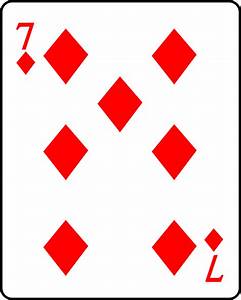
Funnily enough I had never heard of the beer card until I played online when players are not usually in the same location and cannot buy their partner a beer! The beer card is a name informally given to the seven of diamonds. Players may agree that if a player wins the last trick of a hand with the 7♦, their partner must buy them a beer(or a red wine!). This is not considered as part of the rules of these games, but is an optional and informal side-bet between players. This practice likely originates from Danish Tarot or Skat in the middle of the 20th century.
The requirements vary depending on whether the winner of the last trick is the declarer or a defender. In every case, though, the last trick must be won by 7♦ .

For declarer, the requirements are generally that:
- He must make the contract
- Diamonds must not be trumps
- He must take a justifiable line to win as many tricks as possible
For a defender, the requirements are generally that:
- The contract must be defeated
- Diamonds must not be trumps
- He and his partner must try to win as many tricks as possible
- His partner must try to stop him winning the last trick with 7♦
If the contract is doubled, then two beers are earned. If the contract is redoubled, then four beers are earned.
|
|
|
|
The pack of cards

When playing bridge we must spend hours looking at cards, they are everyday objects to us which we take for granted. Yet they have a history of use in Europe which goes back to the late 1300s; their design hasn't changed much since medieval times.
Plenty of historians argue about who really invented the first playing cards. Some say it was the Chinese with their game of “piper tiles”, others claim cards came from Arabia as a “Saracen’s game” in the 14th century. Still others suggest that fortune-telling cards from India were what kicked it all off.
If the English/French style cards are the only sort of playing-cards you have come across you may think that there is only one basic design for the faces of cards, with just the design on the back varying. You would be wrong! In other European countries games such as Skat, Jass, Mus, Scopa, and Tarock are played, using cards of totally different face-designs many of them with roots far older than English/French cards.
Most countries have their own designs, popular locally. These are very often far more colourful than the English one and beautifully printed. The composition of the pack often changes with the game which is being played; a Swiss players sitting down to play jass expects to find 36 cards in their pack, German skat players use 32 cards, while the dealer of French Tarot has to cope with 78 large cards in their hand. Spanish playing cards, baraja were introduced to Spain by the Moors during the 14th Century, usually made up of 40 or 48 cards the Italian deck is very similar, in fact Spanish cards are often used in southern Italy, as well as parts of France, Histpanic America, Northern Africa and the Philippines.
All sets of playing cards are divided into “suits.” The suits we are most familiar with today are of course hearts, diamonds, clubs, and spades, but these are not the only options. In Europe alone we also see; leaves, acorns; shields; coins, cups, swords and batons
While suits might have changed throughout the centuries, “face cards” have remained relatively unchanged.. Although the modern-day “jack” card came about when the Germans completely removed queens from their card decks and instead had kings, upper men (obermann), and lower men (untermann). The lower men cards became jacks
We will be looking at each of the face cards in seperate artciles.
|
|
|
|
Acol

Acol is named after the Acol Bridge Club in London NW6 where it originated in the early 1930s.The club was founded on 15 Acol Road, West Hampstead. The road was named after a small village called Acol, in Kent.
Members Jack Marx and S.J. 'Skid' Simon were very interested in bidding systems and along with other club members such as Maurice Harrison-Gray, Iain Macleod (who went on to become Chancellor of the Exchequer) and Terence Reese (one of bridge's most prolific authors) developed the Acol system and named it after the road of the club. The system evolved over many years, but brought them immediate success and domestic domination.
The first book on the system was written by Ben Cohen and Terence Reese. Skid Simon explained the principles that lay behind the system and the system was further popularised in Britain by Iain Macleod.Some of the games greatest bridge books were written by this group including ‘Why You Lose at Bridge’ (Skid Simon) and ‘Bridge is an Easy Game’ (Iain Macleod).
In the early 1950s the club was relocated to its current premises - a large three-storey detached Victorian house at 86 West End Lane, just a stone’s throw away from the club’s original home in Acol Road.
The club thrived until the mid 1970’s when a variety of factors contributed to a slow decline. The 1968 Gaming Act created problems, as did the emergence of local competition but the hardest transition of all was with the form of the game being played. The club went through some difficult times changing from gambling style rubber bridge to duplicate bridge, but now is again enjoying better times
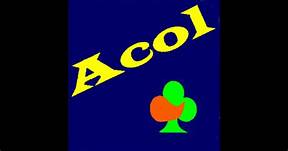
|
|
|
|
The American Contract Bridge League (ACBL) museum
If you ever find yourself in Horn Lake, Mississippi then you must visit the musuem there that is totally dedicated to the game of bridge. It has the premier collection of bridge related artifacts in the world, as well as an interactive showcase of the history of the game. There are many trophies on show and touch screen technology allows visitors to research the history and winners of the trophies in front of you. The musuem is open during weekdays and admission is free.
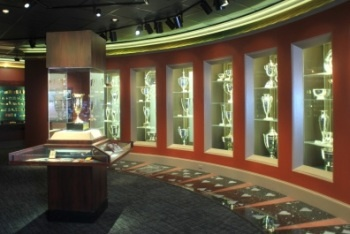
|
|
|
|

SAYC (Standard American Yellow Card)
SAYC is a bidding system based on 5-card majors and a strong 1NT. It is prevalent in online bridge games and derives its origins from the ACBL (American Contract Bridge League). It was created in the 1980s for tournament play. The intention was to offer "Yellow Card" events in which everyone played the same system, thereby avoiding alerts and misunderstandings.
When online duplicate bridge began in the late 1990's, SAYC filled the need for a default convention card and was quickly adopted by online platforms such as Bridge Base Online and ironically is the most popular system in America today and without question the most popular and usually default system played online. Fullfilling the ACBL's original vision.
Online adoption has led to grassroots modifications of the system, with some players defining "SAYC Basic" vs. "SAYC Full". Officially, the ACBL does not make this distinction.
It is also worth noting that SAYC lacks several conventions and treatments that are popular in modern tournaments but is perfect for the random nature of casual online play.
|
|
|
|
PICTURESQUE BRIDGE CLUBS

Lots of bridge clubs have beautiful settings for playing bridge. In this series we periodically look at some of the most aesthetically pleasing bridge clubs around the world.
Please feel free to send your favourites to us.
1 - LA JOLLA COVE BRIDGE CLUB
This historic club building is perched directly on the renowned La Jolla Cove (San Diego) with unobstructed views of the Pacific Ocean.
First opened in 1939, when bridge was played on shuffleboard courts, the club play every Wednesday, Friday and Sunday at lunctime.
|
|
|
|
World Mind Sport Games

The World Mind Sport Games is a quadrennial multi sport event created by the International Mind Sports Association (IMSA) as a "stepping stone on the path to introducing a third kind of Olympic Games (after the Summer and Winter Olympics).
Five mind sports participated in the first Games in 2008: bridge, chess, draughts (checkers) go (weiqi) and xiangpi (Chinese chess), half the participants were bridge plays.
Thirty-five gold medals were contested by 2,763 competitors from 143 countries.
Mahong was introduced as the sixth mind sport in 2017 and poker is under consideration for inclusion at future events.
|
|
|
|
Blast from the past

No one at the club can forget when Norway won the Bermuda Bowl for the first time, back in October 2007. Everyone on that momentous occasion helped Stein and Lidvor celebrate, courtesy of the "free bar" for the afternoon that the couple provided as a result of this famous Nordic victory.
The young gold medalists (Boye Brogeland, Erik Saelensminde, Glenn Groetheim and Tor Helness) overcame a United States team that included Zia Mahmood. The Netherlands finished third.
One of the telling moments in the match was this board.
The diagramed deal was the 36th of the Bermuda Bowl final. When there were large swings in the match, it was usually because of error. But on this deal Helgemo generated a swing with a well-timed double that would not have occurred to many players, the Norwegians followed it up with card-perfect defense. The audience was expecting Helness (West) to start with the heart eight, but he did better, leading the top card of his long suit: the club ten.
In the other room the auction was identical except that Saelensminde (North) ran from one no-trump to two hearts, which was passed out, Weinstein (East) not doubling..
Minus 300 and plus 1,100 gave Norway 13 imps on the one board.
|
|
|
|
|
|
Tournament Bridge in England: 1925-1945 by Richard Fleet
Today's daily snippet looks at the book by bridge historian David Fleet, entitled Tournament Bridge in England.
The non playing captain for England on more than 30 occasions has made his book available online for free
The book looks at the competitions that took place during this key period during the games history and also focuses on some of the main contributors, personalities and great players of the era
Click on the link for access to the book ...here
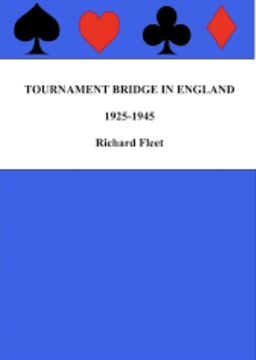
|
|
|
|
MBE for services to bridge
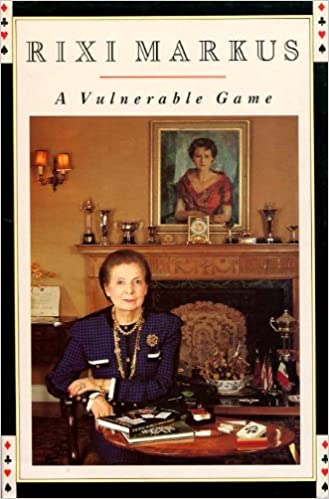
Rixi Markus, one of the greatest female players of all time was awarded an MBE (Member of the British Empire) for her services to Bridge in 1974.
In a career that lasted over 60 years she had far more victories with players from other nations than any other player. Playing for Austria in the World Championship in 1937 she changed her allegiance to Great Britain later on in her career and made numerous appearances in prestigious tournaments for them in the fifties, sixties and seventies.
She was the Bridge correspondent for the Guardian and the London Evening Standard and organised an annual bridge event for both Houses of Parliament annually for several years.
She died in 1992 at the age of 81.
|
|
|
|
Event Programmes
For quite a while now some of the top bridge tournaments have produced official programmes for the events as momentos for spectators and participants alike.
An example of this is the 1974 programme from the World Bridge Olympiad played in Las Palmas in the Gran Canarias.

The winners of the mens event that year were Bob Hamman and Bob Wolff of the USA whilst the Women´s competition was controlled from start to finish by the British pair Rixi Markus and Fritzi Gordon.
|
|
|
|
Fritzi and Rixi

Fritzi Gordon and Rixi Markus are arguably the most famous and tempestuous female partnership in the history of the game of bridge. The pair hold the proud record of being the first and second women to attain the rank of WBF Grand Master.
Excitable and voluble, their post-mortems could often be heard many tables away, but it did not stop them winning a plethora of titles on the world stage.
|
|
|
|
Women in Bridge
 Are women equal to men when playing bridge? The fact that there are events for women only says a lot. There are no men only events since some time ago a women sued the ACBL because she couldn’t play in a men's pairs event with her husband The ACBL resolved this dilemma by discontinuing men only events. One of the beauties of bridge is that, at a club level at least, men and women play on a level playing field. Sadly, at the top level men domininate the rankings. Are women equal to men when playing bridge? The fact that there are events for women only says a lot. There are no men only events since some time ago a women sued the ACBL because she couldn’t play in a men's pairs event with her husband The ACBL resolved this dilemma by discontinuing men only events. One of the beauties of bridge is that, at a club level at least, men and women play on a level playing field. Sadly, at the top level men domininate the rankings.
For me the famous female player that springs to mind has to be Rixi Markus an Australian and British internation, who was featured on our site previously. She was the first woman to become a world grand master. She was clearly a good partner and after her death it was reported that she had far more victories with partners of assorted nationalities than anyone else had ever had. The first women elected to the bridge hall of fame and considered one of the best women players of all time is an American, Helen Elizabeth Sobel Smith. She was a brilliant card player and the first woman to play in the Bermuda Bowl. Her declarer skills were legendary. When Smith died of cancer in 1969, the Bulletin remembered her as a player “without a peer among women and very few peers among men. Helen played like a man, it was true. But she also played like a lady.” Maybe a newspaper couldn't make that statement today, but it clearly indicates the high regard in which she was held.
|
|
|
|
Bridge's Olympic Medalist
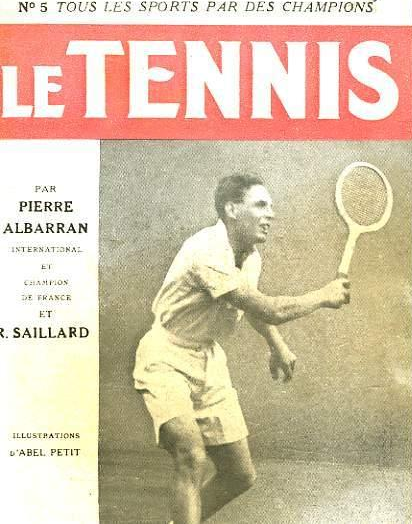
Did you know that Frenchman Pierre Albarran played on the French Open Bridge team that won the European IBL Championship in 1935 and that he also played in over 30 international bridge competitions for his nation, winning 19 national titles.
Furthermore, he represented France in two Davis Cup competitions and he was an Olympic bronze medalist in the 1920 Summer Olympics with his tennis doubles partner Max Decugis.
|
|
|
|
 Oh Hell, Basas and Plump Oh Hell, Basas and Plump
Oh Hell is a trick taking card game similar to bridge. Played by the likes of Bill Clinton and Steven Speilberg the main difference from the standard game is that the object of the game is to take exactly the amount of tricks bid. Taking more tricks than bid is classified as a loss.
Countries around the world have different names and versions for the game, some more colourfully names han others. Examples of the more intriguing names for the game are Basas (Mexico), Plump (Sweden) and Bugger It in Australia. In Spain it is more commonly known as Wizard and uses 60 cards instead of the usual 52 card deck..
|
|
|
|
The bridge kidnapping

In July 1984, Edith Rosenkranz, the wife of the top class bridge player George, was kidnapped at the summer North American Bridge Championships in Washington, D.C.
The kidnappers Glenn I Wright and Dennis Moss asked for a ransom of one million dollars. They were soon captured by the FBI, the ransom money was recovered, and Edith was returned to safety.
A third defendent Orland D Tolden was also implicated and all three received lengthy custodial sentences.
|
|
|
|
Mapp and Lucia

The Mapp and Lucia novel by E.F. Benson has the game of bridge as one of the central themes of the book. Set in polite 1930's society Lucia (recently widowed) is the newcomer to the village of Tilling and is eager to wrestle the reins of social supremacy in the neighbourhood from Miss Mapp. They use drawing-room bridge evenings as deadly weapons to plead their case on the other villagers. Benson's charming satire turns the pretentions and snobberies of English village life into a vicious comedy.
|
|
|
|
Campeonata de España
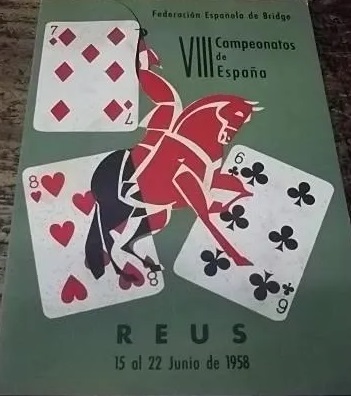
For the Campeonata de España each of the autonomous communities with more than 100 bridge associates have the right to send a number of pairs to the Spanish National Championships.
As of 2019 eleven comunidads met that condition, Madrid, Cataluyna, Galacia, Valencia, Gran Canarias, Asturias, Castilla y Leon, Andalusia, Cantabria, the Basque region and the Balearic Islands.
How many pairs compete exactly from each communidad is determined by several factors, like association numbers,who are the provincial host for that year, and past performances in the Campeonata.
The 2020 championships are currently still scheduled to be held in Tenerife later this year. Players from our very own Jávea club have held this prestigious title in the past.
|
|
|
|
Is Bridge a sport?

The lingering debate of whether bridge is a sport or not has gone all the way to the law courts in recent times. American´s most influential Sports magazine Sports Illustrated certainly thinks so. The cover of one of their 1957 October editions asked "How good a bridge player are you ? Charles Goren tells you.
Goren the American bridge player and writer who significantly developed and popularized the game also appeared on the cover again in 1960. Sports Illustrated itself was the first sports magazine with a circulation over one million to win the National Magazine Award for General Excellence twice
|
|
|
|

The Lone Wolff - Autobiography of a Bridge Champion
As a multiple world champion, and former president of the World Bridge Federation, no-one is better placed than Bobby Wolff to discuss the big issues that face the game today. Wolff talks authoritatively about destructive bidding systems, cheating at the top level of the game, sponsorship, professional players, as well as other issues.
Currently available on Amazon, Ebay and other on line stores.
|
|
|
|
What is a coup?
A coup is the name given in bridge to a type of technique that denotes a specific pattern in the lie and play of the cards. They are many possible card layouts and hence a lot of coups. Coups are normally named after players who performed these plays and made them famous.
|
|
|
|
Church of the Virgin of Loreto

The Church of the Virgin of Loreto is located very near the port. It was built in 1967 and has an architecture that is very modern, made of reinforced concrete. The architect was Fernando Garcia Ordoñez, who won the National Architecture Prize in 1969 for the design of the church. The church has only one nave and the altar is very simple. The outside of the church shows 12 anchors that support the church and these are supposed to represent the 12 Apostles. More on the Virgin of Loreto when the town holds their fiesta in her name. (September)
|
|
|
|
Montrose Bridge Club
 Montrose Bridge Club were our opposition in our first ever online competition as a bridge club. Montrose Bridge Club were our opposition in our first ever online competition as a bridge club.
Playing on a Tuesday evening at the Congregational Church Hall on Baltic Street the club is over 71 years old.
Connected with Jávea Bridge Club, because of John and Sarah Williams, who are members of both clubs, our Scottish friends have numerous top players including Ronan Valentine and Liam O´Brien, who were part of this years winning team that won the Under 26 Camrose Cup(see snippet) for Scotland for the first time since 2012.
We look forward to more competitions and involvement with our Scottish counterparts in the near future.
more about Montrose Bridge Club
|
|
|
|
Camrose Trophy
 The Camrose Trophy or "The Camrose" is an annual Bridge Competition among open teams representing the four Home Nations of Great Britain (England, Scotland, Wales and Northern Ireland) and the Republic of Ireland. Since 2007 it has been a six team competition with the defending champions allowed the opportunity to compete to retain the trophy. The Camrose Trophy or "The Camrose" is an annual Bridge Competition among open teams representing the four Home Nations of Great Britain (England, Scotland, Wales and Northern Ireland) and the Republic of Ireland. Since 2007 it has been a six team competition with the defending champions allowed the opportunity to compete to retain the trophy.
Lord Camrose, owner of The Daily Telegraph, donated the first trophy in 1936, and it was then contested a year later, with England emerging victorious. The Camrose holds the distinction of the worlds most played international bridge series, and they now include a Women's tournament (started 1950), a Juniors competition (started 1971) a Under 19 match up (started 1990) and a Seniors event (started 2008)
Jávea Bridge Club have our own "International" match of sorts today, as several club members pilot an online team match against Montrose Bridge Club of Scotland. If the trial match proves successful more events are planned whilst the lockdown continues.
Please let us know if you are interested in participating in future events.
|
|
|
|
Benji Acol
 Most of us are familiar with Benjaminised Acol (shortened to Benji Acol) a weak two approach to bidding. Normally the weak two refers to a major, but can also include a weak diamond suit as well, but do you know it's origin? Most of us are familiar with Benjaminised Acol (shortened to Benji Acol) a weak two approach to bidding. Normally the weak two refers to a major, but can also include a weak diamond suit as well, but do you know it's origin?
The system is named after Albert Benjamin, a Scottish international bridge player, born in Glasgow to a Swedish father and a Siberian mother. He learnt bridge whilst studying medicine at Glasgow University and later opened a bridge club in the city. He also wrote a daily column for the Glasgow Evening Citizen for several years. He is the name behind the "Benjamin Twos" bid. It was devised along with Acol in the 1950's as a tool to combat the USA Teams weak two system that was wrecking havoc in International competitions.
Benjamin died in Glasgow in 2006 at the grand old age of 96.
|
|
|
|
Another type of bridge auction

An original hand drawn "Peanuts" Comic strip from 1952 showing Charlie Brown and Patty playing bridge went under the hammer last year at auction in Los Angeles.
Catalogued as below, the item failed to meet its minimum asking price of $40,000 dollars and went unsold.
"Charles Schulz original hand-drawn ''Peanuts'' comic strip from 25 October 1952, just two years into the series' run. Strip features Charlie Brown and also Patty, the only female character in the strip's early days. Here the two play bridge, with Charlie Brown having to take notes to keep up. Strip measures 29'' x 6.75''. Light soiling and moisture spots, overall very good condition."
|
|
|
|
When would you want a yarborough?

It is very rare that a bridge player would want a Yarborough (a bridge hand with no card higher than a nine). One such exception may have been in the 19th Century when the British Earl of Yarborough would offer a wager of 1,000 pounds to 1 pound against picking up such a hand at whist.
With the passage of time, the North Lincolnshire town became synonymous with bridge and it is now recognised as a common term that used throughout the world for this weak holding.
|
|
|
|
Aces and Knaves.
There have been numerous documentaries made about Bridge in recent years, Double Dummy, The Sheriff of Bridge and In the Cards to name a few.
The latest to hit the market is entitled Aces and Knaves and it explores the mental side of the game. To get an appetite for the documentary, click on the trailer link below ....

link
|
|
|
|
Omar Sharif Bridge Circus
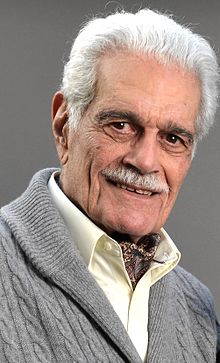
One of the most famous players to play bridge was the actor Omar Sharif.
An accomplished player who was once ranked in the top 50 in the world, he played in the 1964 and 1968 World Bridge Olympiad, representing the United Arab Republic and Egypt respectively.
In 1967 he formed the Omar Sharif Bridge Circus that toured throughout Europe. He invited members of the Italian Blue Team and other professional players to showcase their talents in exhibition matches throughout the continent. The tour expanded to America and in 1990 he created the Omar Sharif World Individual Championship with the largest prize money in the history of the game ($200,000).
At the turn of this century, Sharif stopped playing bridge, stating it was an addiction and that he did not "want to be a slave to any passion anymore". Sharif passed away of a heart attack in Cairo in 2015 but his name will be forever synonymous with bridge.
|
|
|
|
Bob Hamman
 Bob Hamman is one of the greatest bridge players of all time. His resume includes 12 world titles for the United States, along with 50 North American Bridge Championships. Bob Hamman is one of the greatest bridge players of all time. His resume includes 12 world titles for the United States, along with 50 North American Bridge Championships.
Born in California in 1938, Hamman, 82 this year, is still one of the worlds top ranking players. His parents, a salesman and a telephone operator, allowed him to play poker for money as well as chess in high school. Although Hamman was particularly interested in chess, bridge became his obsession during college. At UCLA, Hamman played rubber bridge incessantly. He ultimately dropped out of school and became a regular at the L.A. Bridge Club to earn his living expenses.
In 1964, Hamman played with Don Krauss in the World Team Olympiad, The event was Hamman's first world competition and encounter with Italy that started a rivalry which would last for decades. In 1969 Hamman joined a new professional bridge team named the Dallas Aces, the first of it's kind. This American squad dominated the global bridge scene for a while, winning the Bermuda Bowl world title in Stockholm in 1970, and again in Taipei in 1971. The Aces attempted to defend their title in 1972, but their arch rivals, The Italian Blue Team (Squadra Azzurra) beat the Aces in the final, and also won the ensuing Bermuda Bowl championships in 1973, 1974 and 1975. One of the Itailian pairs were later accused of cheating, this upset Hamman immensely, he always suspected the Italian of suspicious behaviour and sadly he was correct. Hamman did not represent the U.S. in the 1976 Bermuda Bowl. However, he captured the title for the third time in 1977 winning against the defending U.S. champions (this was the first year one country could have more than one team in the event). In the 1983 Bermuda Bowl. Hamman and Wolff alongside teammates Peter Weischel and Alan Sontag, battled against Italy in a dramatic final. Hamman later described it as "the best of all wins... it was the first time we had beaten the Italians. The way it unfolded, it was a 176-board match and it was a dogfight throughout. Finally, it came down to the last four hands, and when the music stopped, we were ahead."
Since then, Hamman has continued to play bridge at the highest level. He has won additional Bermuda Bowl titles (1985, 1987, 1995, 2000, 2003, 2009) and a slew of national titles Hamman's capture of the 2009 Bermuda Bowl was with Team Nickell, while playing with fellow expert Zia Mahmood.
Hamman's Law is one of Hamman's popular contributions to bridge. The adage says, "If you have a bidding decision to make, bid 3NT if it's a plausible choice."
|
|
|
|
Zia Mahmood
 Zia was born in Karachi, but was raised in England. He qualified as a Chartered Accountant. Although he spent three years running the family newspaper chain in Pakistan and eighteen months in Abu Dhabi developing business interests, he has been based in the UK and USA the majority of his life. Zia was born in Karachi, but was raised in England. He qualified as a Chartered Accountant. Although he spent three years running the family newspaper chain in Pakistan and eighteen months in Abu Dhabi developing business interests, he has been based in the UK and USA the majority of his life.
He has been a professional player from an early age and achieved international bridge fame, almost overnight, during one fortnight in 1981 when he led Pakistan to a second-place finish in the Bermuda Bowl tournament. That was the first participation by anyone from the World Bridge Federation geographic zone "Asia and the Middle East", at the time anyone from outside Europe and the United States was a rarity and still is to this day. Five years later, Zia led a short-handed team from Pakistan to second place in the 1986 Rosenblum Cup tournament, which is the open world championship in even-number non-Olympic years. Zia has since represented the United States in world competition, and thus he won his first major world championship, the 2009 Bermuda Bowl. However, he still considers himself Pakistani: "I am proud and happy to be representing America, but my Pakistani identity is in no way submerged. I feel like a Pakistani who is living in America and playing for America." To prove his point, Zia and his American teammates once played their opening match in Pakistani dress.
His major successes in English bridge include victories in the Gold Cup (three times), Spring Foursomes (three times), Crockfords Cup, and in key events at the Summer Meeting, and London Year End and Easter Congresses.
He used to write the Guardian bridge column until the paper decided to discontinue bridge coverage and still a well known flamboyant character on the London Bridge scene.
|
|
|
|
The Blue Team (Squadra Azzurra)
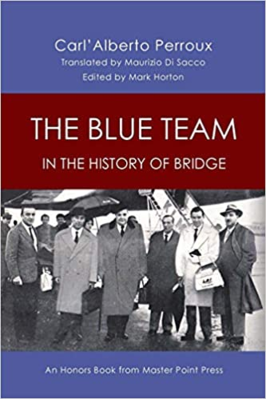
On the International bridge scene one of the most renowned teams in the history of the game is the Squadra Azzurra. (The Italian Blue Team)
Carl Alberto Perroux (1905-1977) was president of the Italian bridge federation from 1952 to 1967 and during that period he founded the Blue Team. A trial lawyer in private life (he was deemed to be the best criminal lawyer of his time), Perroux was responsible for turning a group of talented inviduals into three partnerships and secondly, a team.
The three partnerships (Walter Avarelli-Gergio Balladona, Pietro Forquet-Benito Garozzo and Massimo D'AlMassello) along with a rotating fourth pair won sixteen world titles over an eighteen year span.
They also won three world team olympaids and four european championships. Their domination began to wain when several of their core players retired from international competition in 1969, although they did win consecutive Bermuda bowls in 1973,74 and 75.
An account of the Italian blue team can be found in the book by Perroux entitled quite aptly "The Blue Team in the history of bridge"..
|
|
|
|
 Hesitation Hesitation
Some of you may have been surprised by the comment in the quick tip section yesterday that faking thinking is against the laws. Here is an incident reported by the WBF (World Bridge Federation) :
During a high stakes game one day, the legendary Alvin Roth and his partner found themselves defending a 7NT contract.
On the third last trick, declarer, sitting East, with the ace and king in dummy, led the jack of spades. Roth’s partner (sitting South) pretended a painful hesitation before playing his card; he hemmed and hawed, pulling out one card and then another, before playing low to the jack.
Declarer, assuming after all this performance, that South must have the queen, took a chance and let the jack ride. Though Roth, in fact, possessed the queen and (playing last) could have won the trick and defeated the contract, he opted instead to play a lower card.
Declarer won the trick and, with ace, king in dummy, easily made his contract. Afterwards, Roth was upbraided by his partner for blowing the game. “For Heaven’s sake, Alvin,” he exclaimed, “why didn’t you take the queen?”
Roth, a famously ethical player, stared the man down and wryly replied: “You hesitated so long, I thought you had it.”
|
|
|
|
Sorolla
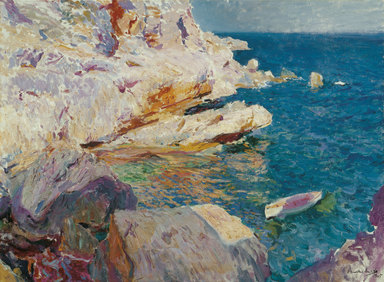
Joaquín Sorolla visited Jávea for the first time in 1896. His surprise at its beauty and the difference of its coastline compared with that of Valencia are evident in a telegram he sent to his wife on his arrival and in a subsequent letter: "Sublime Jávea, immense, the best I know for painting ... I shall be here a few days. If you were here, two months." And: "This, Xàbia, has all that I could wish for and more, and if you could see what I have in front of my cottage, you’d be lost for words to praise it; I fall silent from the emotion that still grips me; imagine, my house is on Monte Carlo itself; this is all a mad dream, just like living on the sea, aboard a great ship. You made such a mistake in not coming!! You'd be so happy... You'd enjoy yourself so much! [...] this is the place I've always dreamt about, Sea and Mountains, but what a sea!" He returned there to paint in 1898, 1900 and 1905.
This beautiful picture, Rocks at Jávea. The White Boat, comes from the last year of painting in Jávea. It was a summer he would remember fondly for the rest of his life, often referring to it in letters to his wife, for they were happy days full of great artistic achievement.
|
|
|
|
Poem of the day
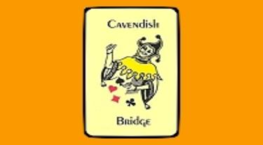 In celebration of National Poetry Month we offer a poem for today´s daily snippet. In celebration of National Poetry Month we offer a poem for today´s daily snippet.
“Contract Bridge” by B. Jay Becker
Becker was an American lawyer and bridge champion who was twice a world champion (winning the Bermuda Bowl in 1951 and 1953). Over the years he managed three New York bridge clubs (The Cavendish, the New York Bridge Whist and the Regency) and he was inducted into the ECBL Hall of Fame in 1995
(click on the whole post to see the poem in a new window)
|
|
|
|
Bridge on Cruises

Many of our members have enjoyed the combined experience of playing bridge whilst cruising around the Mediterranean, the Carribean or other exotic places but did you know that history suggests that the game as we know it was created in 1925 by the American socialite Harold Vandebilt whilst on the steamship cruiser SS Finland..
His vision of the "new game" implemented a "sophisticated scoring system" and introduced the concept of vunerability to take the game from auction bridge to contract bridge.. He devised "a contract" with penalties for failing to make the agreed result and successes for achieving it. This new format quickly gained popularity, especially in the United States and soon after became the standardized form of the game.
Vanderbilt, a keen yatchsman, wrote the book, Contract Bridge : Bidding and the club convention in 1929 and appeared on the cover of Time magazine for his various achievements in September 1930
|
|
|
|
Today's daily snippet comes in the form of an Easter Quiz
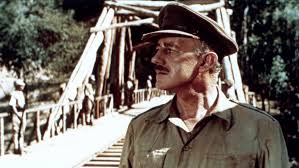
Anagrams of films with bridge or bridges in the title - can you name them?
1 I SWERVED BIG - 1932 film directed by Fatty Arbuckle
2 - ABIDE TO GROWLER - 1940 movie starring Vivien Leigh and Robert Taylor
3 - DO BRIGHTER CASES - 1957 (sept) - movie starring Rod Steiger based on a Graham Green short story
4 - OVERTAKING THE HIRER WE BID - 1957 (oct) won seven academy awards including best movie
5 - GRIME BAG THREATENED - 1969 fictionalised war movie based on the non fiction book by Ken Hechler
6 - WORDING A BRIBE - 1971 film featuring the music of Jimi Hendrix
7 - GOOFIER BAD ART - 1977 movie directed by Richard Attenborough
8 - BIG FRIAR FIDGET - 1990 rock musical written, directed and starring Prince
9 - REFRESHINGLY ABOUT SIDE - 2004 Kathy Bates and Robert De Niro star in a film based on the novel by Thorton Wilder
10 - DEBRIEF GOSSIP - 2015 Legal thriller directed by Spielberg
ANSWERS . . . .
1- Bridge wives
2- Waterloo bridge
3- Across the bridge
4- The bridge on the river Kwai
5- The bridge at Remagen
6- Rainbow bridge
7- A bridge too far
8- Graffitti bridge
9- The bridge of San Luis Rey
10- Bridge of spies
..... see less
Today's daily snippet comes in the form of an Easter Quiz

Anagrams of films with bridge or bridges in the title - can you name them?
1 I SWERVED BIG - 1932 film directed by Fatty Arbuckle
2 - ABIDE TO GROWLER - 1940 movie starring Vivien Leigh and Robert Taylor
3 - DO BRIGHTER CASES - 1957 (sept) - movie starring Rod Steiger based on a Graham Green short story
4 - OVERTAKING THE HIRER WE BID - 1957 (oct) won seven academy awards including best movie
5 - GRIME BAG THREATENED - 1969 fictionalised war movie based on the non fiction book by Ken Hechler
6 - WORDING A BRIBE - 1971 film featuring the music of Jimi Hendrix
7 - GOOFIER BAD ART - 1977 movie directed by Richard Attenborough
8 - BIG FRIAR FIDGET - 1990 rock musical written, directed and starring Prince
9 - REFRESHINGLY ABOUT SIDE - 2004 Kathy Bates and Robert De Niro star in a film based on the novel by Thorton Wilder
10 - DEBRIEF GOSSIP - 2015 Legal thriller directed by Spielberg
ANSWERS . . . ..........
..... see more |
|
|
|
Warren Buffett and Bill Gates

Warren Buffett v Bill Gates, now that is an heavyweight battle everyone would like to see. Both of the successful entrepreneurs are avid bridge players and it seems that Buffett may have the edge when it comes to competitiing against Gates at the card table.
Buffett, who regularly plays up to eight hours a week, quips that it is probably the "only game" that he may be better at than his Seattle born counterpart. He also declares that it is the "best exercise there is for the brain" and implies that the game has helped keep his mind stronger in business situations.
Gates for his part believes "Bridge helps you think. It´s a game you can play your entire life and keep getting better and better" . For further reading on Buffett and Gates and their relationship with the game of Bridge click here
|
|
|
|
World's oldest bridge club

The Portland Club in London is generally considered by many as the oldest card club in the world. Founded around 1815 as the Stratford Club, it was given its present name in 1825.
Ian Fleming was a member of the club and in his novel Moonraker, the Blades Club were James Bond and Hugo Drax play bridge is reportedly modelled on the Portland Club (see yesterday's snippet).
Having lost the lease on its own premises the club now meets regularly these days at the Army and Navy Club in Pall Mall, London.
See here an article on Andrew Robson's website entitled Skillful play at the worlds oldest Bridge Club
|
|
|
|
James Bond

Another fictional bridge player is Ian Fleming's legendary spy, James Bond.
In the movie Moonraker, 007 plays bridge against the evil multi-millionaire Sir Hugo Drax. In the story, M asks Bond to investigate Sir Hugo's substantial winnings at M's favorite bridge club
There, Bond discerns that Drax is a cheat When dealing the cards, Drax peeks at the card reflections in his polished cigarette case
When playing with M, Bond fixes the deck against Drax in the final deal of the session:
This was the hand......
| |
|
M |
|
|
| |
♠ T987 |
|
| |
♥ 6543 |
|
| Meyer |
♦ — |
Drax |
| ♠ 65432 |
♣ 76532 |
♠ AKQJ |
| ♥ T9872 |
|
♥ AKQJ |
| ♦ JT9 |
Bond |
♦ AK |
| ♣ — |
♠ — |
♣ KJ9 |
| |
♥ — |
|
| |
♦ Q8765432 |
|
| |
♣ AQT84 |
|
Bond, South, deals and opens 7♣ ! This is passed around to Drax, who doubles. Bond naturally redoubles.
Bond ruffs a diamond in dummy, finesses Drax's clubs, ruffs another diamond, and finesses clubs again. Now Bond's hand becomes good, and Drax is apoplectic.
This deal is based on the Duke of Cumberland deal from the 19th century. The Duke of Cumberland, son of King George III, supposedly held Drax's cards during this rigged deal against hustlers:
| |
|
North |
|
|
| |
♠ — |
|
| |
♥ — |
|
| The Duke |
♦ T98765432 |
East |
| ♠ AKQ |
♣ AQT8 |
♠ JT9876 |
| ♥ AKQJ |
|
♥ T9876 |
| ♦ AK |
South |
♦ QJ |
| ♣ KJ97 |
♠ 5432 |
♣ — |
| |
♥ 5432 |
|
| |
♦ — |
|
| |
♣ 65432 |
|
The Duke led a low club against 7♣. He was then enticed to bet £20,000 that he would win at least one trick... and lost.
..... see less
James Bond

Another fictional bridge player is Ian Fleming's legendary spy, James Bond.
In the movie Moonraker, 007 plays bridge against the evil multi-millionaire Sir Hugo Drax. In the story, M asks Bond to investigate Sir Hugo's substantial winnings at M's favorite bridge club
There, Bond discerns that Drax is a cheat When dealing the cards, Drax peeks at the card reflections in his polished cigarette case
When playing with M, Bond fixes the deck against Drax in the final deal of the session:
This was the hand. ..........
..... see more |
|
|
|
Songs related to bridge
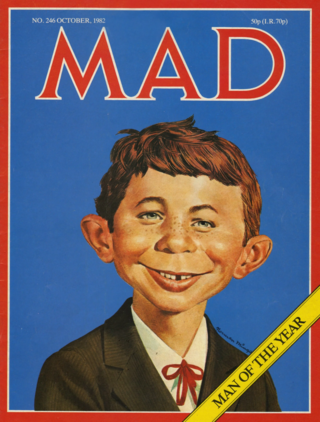
Many songs make references to card games but possibly the most unusual is a parody song A E Neuman and Mad Magazine did a few years ago (as part of an article on fight songs for a variety of high school sports teams).
This song was written in the context of a school that could not afford major sports but had a good Bridge team and was written to the tune of "The Caissons Go Rolling Along" (American forces song)
Here are the lyrics to the song:
Bid a heart, bid a spade,
Bid a game that can't be made,
As the bridge team goes ruffing along.
Lose a slam by one trick,
Watch your partner getting sick
As the bridge team goes ruffing along.
For it's hi hi hee, we've got vulnerability.
Shout out three no trump loud and strong.
Down four!
We will set the pace
As we trump our partner's ace
As the bridge team goes ruffing along
Which songs can you think of that make references to bridge?
|
|
|
|
South African Texas
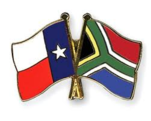 There are some really quirky names for conventions but one of the most geographically challenging must surely be the South African Texas convention.. South African Texas is attributed to Max Sapire of South Africa, a prominent player in the 1960's and 1970's and are transfer bids in response to a 1NT opening that uses clubs and diamonds to transfer to the majors, instead of the standard diamonds and hearts. There are some really quirky names for conventions but one of the most geographically challenging must surely be the South African Texas convention.. South African Texas is attributed to Max Sapire of South Africa, a prominent player in the 1960's and 1970's and are transfer bids in response to a 1NT opening that uses clubs and diamonds to transfer to the majors, instead of the standard diamonds and hearts.
In certain other parts of the world this convention is known as namyats (stayman spelt backwards).South African Texas transfers may also be used as opening pre-emptive bids. A 4♣ and a 4♦ can show a slightly different hand type (usually stronger) compared to a direct 4♥ or 4♠ opening.
|
|
|
|
The Venice Cup
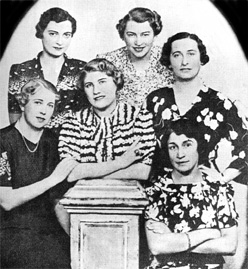
1937 Venice Cup Winners, Austria.
The Venice Cup is a tournament played every two years by the Women's National teams from around the world.
It became known as the Venice Cup because Italy donated the trophy for the competition.
Austria won the first event conducted in 1937 in Budapest, Hungary.
As a sidenote, Rixi Markus (born Erika Scharfstein) was a member of both the 1937champions, and the 1976 Great Britain team that was defeated by the United States. (for more on Rixi Markus click on this article and you should be taken to a Bob Denby's Gem)
The competition is played alongside the Bermuda Bowl and is next scheduled to be played in 2021
|
|
|
|
Stayman Convention

Imagine announcing Marx or Rapée instead of Stayman in your game of bridge.
That could easily have been the case as they were the actual creators of the convention.
Jack Marx first used it in 1939 and Stayman´s regular partner George Rapée implemented it in 1944, but it was Sam Stayman who wrote the first published description in 1945, hence his name is used.
Lots of variations have developed over the years with equally interesting names.
Garbage stayman, Checkback stayman and Puppet stayman are three examples of the subtle differences to the standard stayman convention.
|
|
|
|
A hand of bridge
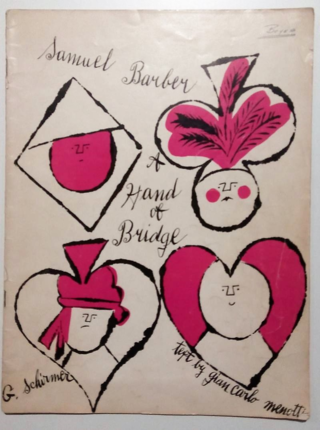
A hand of bridge is an opera in one act by Samuel Barber that lasts only nine minutes.
It was first performed at the Teatro Caio Melisso in Spoleto, Italy in 1959.
The opera consists of two unhappily married couples playing a hand of bridge, during which each character has an arietta in which he or she professes his or her inner desires.
Andy Warhol, a good friend of Barber designed the cover for the opera´s vocal score.
Anyone interested in opera can watch a streaming of Verdi´s Otello for free tonight, at www.lesarts.com
First performed in June 2013, it received a 12 minute ovation at the end of the performance.
The streaming starts at 8pm and will be available to view for up to 48 hours after the assigned start time.
|
|
|
|
JUNIOR GANYMEADE CLUB
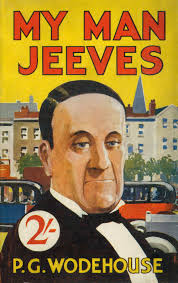
There are many fictional characters that play bridge but very few fictional clubs.
One such club is the Junior Ganymeade Club that is the home club of the butler Jeeves (P. G. Wodehouse). Exclusively a club for valet and butlers it is located in Curzon Street in Mayfair and is mentioned in several of the Guildford born writers books. Once a week Jeeves will take the afternoon off to play bridge at the club.
Aside from socializing, the club´s main activities are bridge and the writing and perusal of the club book. Over eighty years old the clubs constitution requires that every member must record information about their employers in the club book. (at one point 18 pages were dedicated to Bertie Wooster, the employer of Jeeves).
According to historical sources the club is based on a real pub in Charles Street, Mayfair that is called The Only Running Footman, or The Footman for short.
|
|
|
|
Animal Crackers
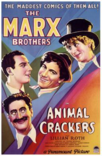
Bridge scenes are often seen in movies but probably the most famous is the one seen in the Marx brothers film Animal Crackers.
Can you think of any other movies that contain references to bridge in them ?
Click on the link "Let's play bridge" to see the scene when Harpo and Groucho try their hand at bridge with Margaret Dumont.
Animal Crackers - 1930
Let's play bridge
|
|
|
|
IT'S ONLY A GAME

It's only a game was a syndicated comics panel by Charles M Schulz, the creator of Peanuts.
Schulz and fellow cartoonist Jim Sasseville produced the strip four times a week focusing on card and board games
Between November 1957 and January 1959 it was distributed by the United Feature Syndicate, who also produced the likes of Peanuts, Dilbert, Garfield and Marmaduke.
The strip was modestly successful, but given the growing popularity of Peanuts, and the resulting demands on his time, Schulz himself cancelled the strip after 63 weeks.
|
|
|
|
ALFRED SHEINWOLD

Alfred (Freddy) Sheinwold was an international American bridge player and prolific writer.
He was also an editor of The Bridge world monthly magazine from 1934 to 1963, but more than anything he was famous for the one liners he came out with in relation to bridge.
Below are some of his more illustrious quips about the game .....
"Count your losers and count your winners. If it doesn´t come to 13, count your cards."
"The real test of a bridge player isn´t in keeping out of trouble, but escaping it once he´s in it. "
"One advantage of bad bidding is that you get practice at playing atrocious contracts."
|
|
|
|
THE BERMUDA BOWL

The Bermuda Bowl is the world championship of bridge that is held every two years. It was first played in 1950 at the Castle Harbor Hotel in Hamilton, Bermuda and is named as a result of the first venue of the inaugural tournament.
USA, Europe and Britain played in the very first Bermuda Bowl and USA won the competition. On their team that year was Sam Stayman, renowned in bridge circles for the Stayman convention.
South America champions joined the event in 1958, followed afterwards by countries in Asia and Australia. The latest tournament was played in Wuhan, China with Poland winning the event. Two other European countries, the Netherlands and Norway finished second and third respectively.
|
|
|
|
Muiderberg Convention

Numerous bridge conventions have curious names. One of the most interesting and difficult to pronounce correctly when surrounded by Dutch players, is the Muiderberg convention that is named after a Dutch Village. Otto Janssens and Willem Boegem were the creators of the convention, and hailed from the small village.Both Janssens and Boegems are Senior International masters and were part of a five man team representing Holland that finished second in the World teams in Istanbul in 2004.
They were beaten in the final by Italy, who included the pair Fulvio Fantoni and Claudio Nunes. The Italian partnership were banned from playing together for life in 2016 as a result of a cheating scandal that rocked the contract bridge world.
Jannsens and Boegems also competed in the Dutch team that finished third out of 42 entraints in the 2006 World Championships in that took place in Verona.
|
|
|
|
CARDS ON THE TABLE - AGATHA CHRISTIE
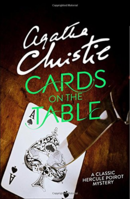
Arguably, the world´s most famous crime writer Agatha Christie wrote one of her best novels around the plot of bridge.The book "Cards on the table" written in 1936, sees Hercule Poirot solve the murder of one of the bridge players and dinner party host, Mr. Shaitana.
Receiving great reviews the author reveals in her foreword that the novel only has four suspects and a physchological deduction is required.
The book has been adapted for stage, radio and television and was even serialised by the American magazine The Saturday Evening Post" prior to its official publication date.
The book is readily available on Amazon and Ebay.
|
|
|
|
Asian Games

There is a long standing debate as to whether bridge is a sport or not. An unsuccessful attempt to participate in the 2020 Olympics came on the back of bridge being accepted as a "Mind Sport" in the 2018 Asian games.
The games played in Jakarta, Indonesia had six different competitions for bridge ; Mens Pairs, Womens Pairs, Mixed Pairs, Mens Teams, Mixed Teams and Supermixed Teams.China won three of the golds, (Womens, Mixed and Supermixed Teams) whilst Chinese Taipei (Mixed Pairs) Singapore (Mens Teams) and India (Mens Pairs) won the other three gold medals on offer.
Played every fours years, the 2022 Asian Games is scheduled to take place in Hangzhou, China from the 10th - 25th September.
|
|
|
|
YOUR JÁVEA - TURNING BACK THE CLOCKS
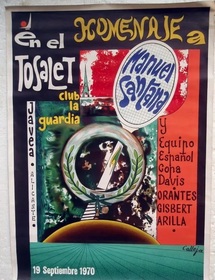
As the clocks spring forward we turn back time to take a look at how Jávea was in 1970. This retro clip was made to coincide with the retirement of tennis player Manolo Santana.
Spain had just won the European zone of the Davis Cup a few months before when Santana had played a pivotal role in securing the trophy.
The tennis club La Guardia in El Tosalet consequently held a tournament in his honour with the other victorious members of the team agreeing to participate in the event.
In the you tube video can see the Parador, the Arenal and a few excerpts from the match itself.
https://www.youtube.com/watch?v=n8xmZ6Jq2TI
|
|
|
|